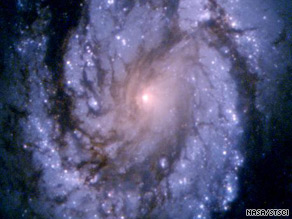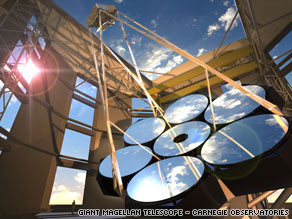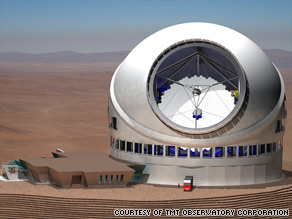 (CNN) -- It may not be possible to travel back in time, but seeing stars and galaxies as they looked millions or even billions of years ago is no problem thanks to telescopes, the closest thing we have to time machines.
(CNN) -- It may not be possible to travel back in time, but seeing stars and galaxies as they looked millions or even billions of years ago is no problem thanks to telescopes, the closest thing we have to time machines.Now, astronomers are holding their breath to see what they'll observe and discover with a new generation of huge telescopes set to be built around the world.
 Peering ever deeper into space and further back in time, the powerful devices will be able to show what the universe was like when it was just a few hundred million years old and emerging from a period of total darkness after the Big Bang.
Peering ever deeper into space and further back in time, the powerful devices will be able to show what the universe was like when it was just a few hundred million years old and emerging from a period of total darkness after the Big Bang."[We'll be] looking at the first generation of stars forming in the universe, which is kind of a cool idea: The time when the lights went on in the universe. There was no light before that time," said Daniel Fabricant, associate director of the Harvard-Smithsonian Center for Astrophysics.
His institution is one of several research organizations and universities developing the Giant Magellan Telescope, to be built in Las Campanas, Chile, by 2018.
'Eye on the sky'
 Bigger is better in the world of reflecting telescopes, which rely on primary mirrors to collect light. The bigger the primary mirror, the more light it can gather and the fainter the objects astronomers can see.
Bigger is better in the world of reflecting telescopes, which rely on primary mirrors to collect light. The bigger the primary mirror, the more light it can gather and the fainter the objects astronomers can see.The world's largest optical and infrared telescopes have primary mirrors that measure about 10 meters (32 feet) across. But the Giant Magellan Telescope will more than double that diameter, with a monster primary mirror spanning almost 25 meters (80 feet).
If the Magellan is the first new-generation star gazer to be built, it may not remain the record holder for long. Another consortium of organizations and universities is preparing to construct the aptly named Thirty Meter Telescope on the Mauna Kea summit in Hawaii, also scheduled for completion in 2018.















No comments:
Post a Comment